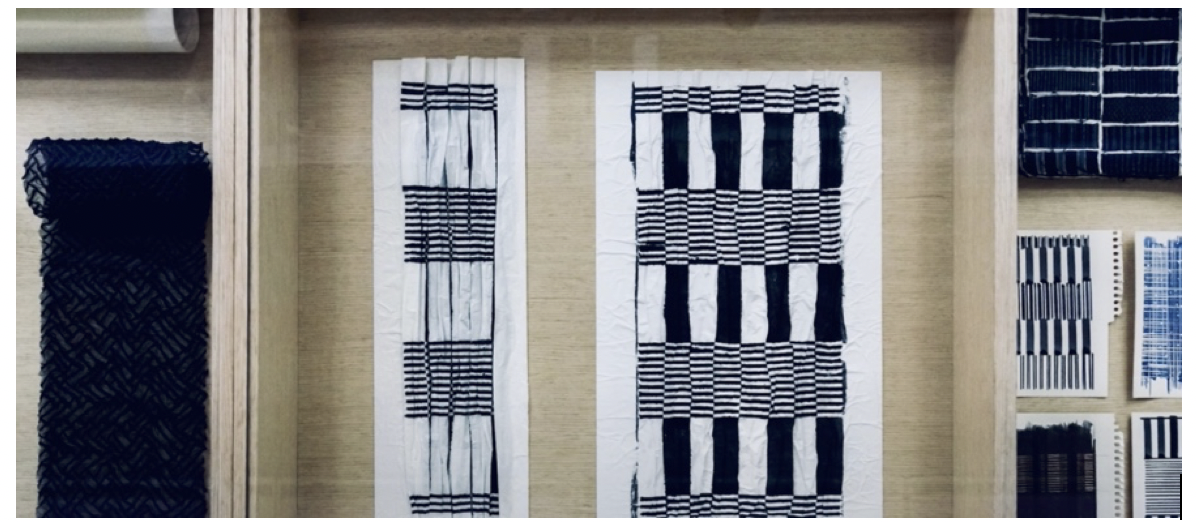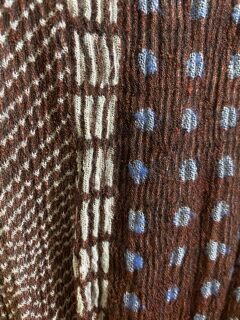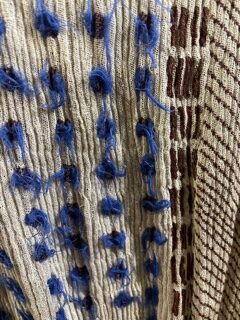Making Nuno

‘Sewing is a way of keeping things together…’
Louise Bourgeois
… and making material is an Art. Weaving is such a primordial pursuit. It was my grandmother who introduced me to textiles from the roots up. She spun wool from her sheep and at times entwined goat’s wool to make the yarn mix more hardy. On summer days I would go down to the river that rushed through the valley and passed through her land, separating the farm with Pigeon rock massive, in The Mourne Mountains. I’d hop from stone to stone right up to the source whence my grandmother’s water came and on the way, stop on ‘the island’ – a big stone in the middle of the river which could hold two or more people. We had picnics there or fish rainbow trout or salmon. On one of those rare occasions when my grandmother would join us and had time to leisurely walk without her signature blue overcoat or apron, she was unusually talkative and leaning down to crouch in front of a stone, she showed me the type of lichens she used to dye her wool. Reverently, viewing the greyish-blue mesh of stuff stuck fast to a granite rock, she explained how it made a difference on which rock the lichens grew. The colours would come out differently, depending on the stone.
Years later in Switzerland, I look at a blanket my mother gave me – a dowry of sorts. My grandmother had spun the wool and another brave lady, Gerd Hey-Edie had woven this monster of a blanket with the colours of the earth, the bracken and the river – the backcloth of Mourne. It is heavy and green and large and has come with me everywhere I have since lived. During lockdown, I decided to darn a small hole that had become a bit larger over the years but unfortunately, I didn’t have the right colours to fix it adequately. One only really sees the colours in a piece of material when one goes to darn it. One looks more carefully and notices the skill of the maker or the lack thereof. It was all dots of turf in a bed of mossy grass, on a turquoise blue warp, regularly punctuated by the creamy-coloured weft. I had nothing of the sort with which to fix it in my collection of yarns so I tried as best I could, to weave the remnant strands together to a cohesive mesh, using a sewing thread in turquoise to fix them in place. It was a bit of a disaster but at least the hole was gone.
We are fortunate today to be connected with other creatives through social media and the lonely life of the artist or artisan is relieved by the gentle comfort of knowing we are not alone. Reaching out on one such occasion, International Women’s Day, to be precise, I wrote a comment on the site of Mourne Textiles. They had posted a photo of the above-mentioned Norwegian designer and weaver, Gerd Hey-Edie. The strange coincidence was that I had used my grandmother’s blanket to say thank you to all the strong women who were the warp and weft of my life on the same day as they posted a photo of its maker. How surprised I was to discover consequently, that it might even be possible to find said yarn in the archives in Killowen, where Gerd’s grandson now oversees her legacy with his mother Karen, in their cosy workshop tucked away on the Old Killowen Road, the back road.
On the same day, the Textile Museum in St. Gallen opened its ‘Making Nuno’ exhibition, showcasing the work of the wonderful Sudo Reiko and her method of designing material (Nuno). Our friend, Micki it turns out, CEO of Fischbacher Textiles, was operative in bringing the exhibition to St. Gallen after it had reached high acclaim in CHAT ( Nov. 2019, Hong Kong), London and Scotland. Unfortunately, Sudo Reiko couldn’t make it to the opening personally but Mr. Simon Wright from The Japan House in London gave a wonderful introductory speech after a personal message from Sudo Reiko was beamed to an attentive audience in the grand hall of the Textile Museum, where we were offered not one but three different strengths of Saki and tasted corresponding cheeses, enhancing the flavours of each. Before the speeches, I had a chance to chat with Simon Wright who kindly demonstrated the method used by Reiko, by taking off his scarf – a piece of art, both back and front. Woven on a loom, traditionally used to make the material for kimono and obi, it turns out to be the perfect width of material for scarves too.


He began his speech by praising the Textile Museum in St. Gallen. The magnificence of its large in-house collection of pattern books and katagami stencils are indeed our treasured heritage. He mentioned how we are connected through textiles – the co-creation, as well as the co-protection thereof. More than 150 years ago, Japan and Switzerland began a fruitful cultural exchange and Sudo Reiko uses a technique today, chemical lace embroidery, which was developed in eastern Switzerland at the end of the 19th century. Around the same time, so-called ‘Japan fever’ swept across Europe and also had a significant influence on arts and crafts in Switzerland. Japanese design is still held in high esteem here.
Sudo Reiko’s work is prolific and innovative, using waste materials left over from silk-making, upcycling the outer husk-like layer of cocoons or kibiso and working with hand-made paper, as well as employing local craftspeople (for whom she has deep respect) – are all aspects that factor in making her Nuno production sustainable, (the latter being the most important in my eyes).
In the exhibition, five large-format installations demonstrate wonderfully the complex production process involved in Reiko’s designs.
My favourite part of the show, however, are the cases wherein sketches and paintings, as well as the raw materials and design prototypes, are displayed. I love her work on washi paper, folded and worked into with watercolour. Humble but strong. I am always interested in the workings of the mind of the artist and the thoughts of the designer behind each piece, so seeing the cross-section of a roll of paper and her use of ribbons to reconstruct her idea was very instructive. It will all make sense when you go and see the exhibition.
The wooden tools, bobbins and shuttles, all well-worn and shining through constant use, are touching remnants of a slower past, speaking to the present through textiles.
‘The future comes from the past,’ as Sudo Reiko mentions in one of her short films. How apt, on this day when some of the yarns, connecting me to my past, might soon be making their way across the sea to me.
Thank you, Mario, at Mourne Textiles and thank you to the Textile Museum in St.Gallen!

6 Comments
Amazing!
This is so beautiful Frances! Love your text! 🙂
Thanks 🙂
Thank you my dear 🙂
Very interesting Frances to read about Granny’s blanket. I remember her wonderful patchwork bedspreads. They were very colourful and very heavy.
The socks that she knitted with her homespun wool from her sheep were really warm. When we stayed on holidays she taught us how to card the sheep’s wool and spin it on her spinning wheel.
Staying at Granny’s ‘Up at the Mountains’ was a magical experience.
Thank you so much for your beautiful memory Maura – much appreciated. I wonder did they realize at the time, the great influence they were having on our lives and how it would affect our appreciation of beauty, real country living and craftwork.
Comments are closed.